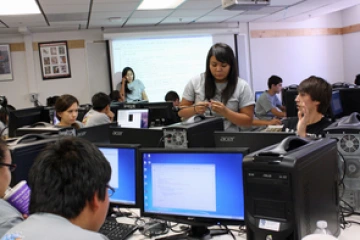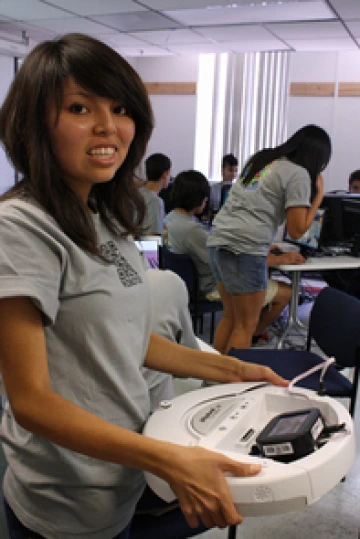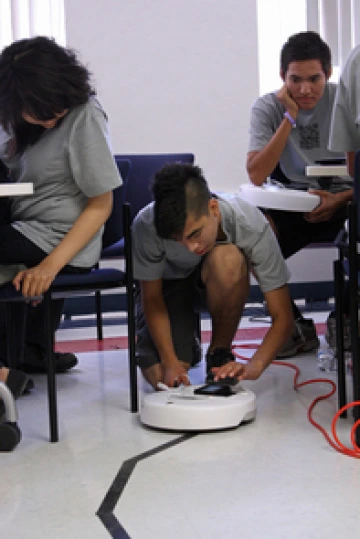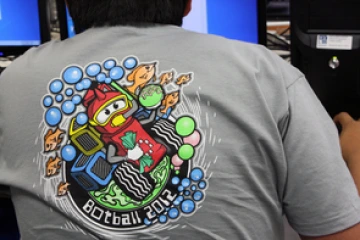UA Program Trains Next Generation of STEM Professionals
The Native American Science and Engineering Program engages high school students in a residential program and year-long activities around the STEM fields.
Adriane Nuñez stood perplexed as Brooke Claw, who was hunched over a stalled robot, tried to figure out a way to make the device follow their commands.
The iRobot was being temperamental. But just moments later, Nuñez and Claw – both high school students – had successfully reprogrammed the robot to follow a zigzagging line of black tape on the floor and, thus, were able to move on to the next, and more complex task.
The two were participating in the University of Arizona's Native American Science and Engineering Program, or NASEP, one for high-achieving students who show interest and great promise in science, technology, engineering and mathematics.
"It's very interesting and engaging," said Nuñez, 16, a member of the Tohono O'odham Nation. Though she has not yet decided on what branch of engineering to pursue, Nuñez said she had the opportunity to scout out options.
Part STEM exploration, part higher education immersion, the students spent one week living in a UA residence hall as part of the residential portion of NASEP, which culminated June 15. While at the UA, participants and their families took part in an orientation, and students toured Biosphere 2, visited UA laboratories and connected with University students, faculty and staff.
This year's cohort, the fourth for NASEP, also was engaged in discussions around American Indian well-being, including issues related to professionalism, physical activity, emotions, spirituality and the environment. To date, more than 70 students have been involved in the program.
"These are high-achieving students, and because they are juniors and seniors, a lot of them have already completed their math and science requirements," said Christine Nelson, a graduate assistant for NASEP.

The Native American Science and Engineering Program is a year-long program designed to connect high school students interested in science, technology, mathematics and engineering to UA, industry and professional opportunities and contacts. Students also are paired with mentors and, come this fall, some of them will participate in a grant-funded water quality research initiative. (Photo credit: Beatriz Verdugo/UANews)
"But we want to make sure they don't just stop," Nelson said, adding that many of the students have taken advanced placement courses but that the program also helps enhance their readiness for the SAT.
Also, the students will be involved in a research project beginning in September. "Mother Earth and Her Ecosystems: Research, Education, and Outreach Opportunities for Native High School Students" as part of an National Science Foundation grant is designed to generate interest in geosciences.

Led by the American Indian Science and Engineering Society, AISES, chapter at the UA, a group of 20 NASEP participants will stay at the Biosphere 2 overnight, where they will attend a research symposium and also be trained on how to conduct the field experiment on water quality in their home communities. The students then will be equipped with testing kits so that they may involve other youth in the project.
Brooke Claw, who is 17 and a member of the Navajo Nation, said she has an interest in computer engineering. Claw and members of her team spent time during the residential portion of the Native American Science and Engineering Program learning about computer programming through interactive involvement with robotics. (Photo credit: Beatriz Verdugo/UANews)
"It's rare to see that type of research on a high school student's resume," said Rudy McCormick, who directs the UA's Office of Early Academic Outreach, which oversees NASEP. "And to be able to work with UA faculty will be very meaningful to these students."
That reality is familiar to Darci Reid.
While accomplished academically, Reid said she struggled in applying for the Honor Society because she had little exposure to advanced coursework and laboratory time.
"But here, we're getting the experience and help with deciding what it is we want to do," said Reid, 17, a member of the Navajo Nation who lives in north central Arizona.

Also, as part of their involvement with NASEP, the students received iPads and, throughout the year, will connect with one another – a boon to improving contact with other academically engaged and like-minded students, Reid also said.
And their mentors at the UA will be in constant contact as well, checking in about academic and extracurricular activities and also college plans, Nelson said.
"We want them to have increased exposure because, at the same time, it teaches them the rigors of college," said Nelson, a doctoral candidate in the UA's Center for the Study of Higher Education.
Students were split into eight teams. Participants, including (left to right) Hannah Allison, Nathaniel Dominguez and Junior Allison, were then responsible for writing computer programs, conducting simulations and testing their robots. (Photo credit: Beatriz Verdugo/UANews)
Jared Fowler, a member of the Navajo Nation and a UA alumnus who assisted NASEP students, said the experience they were having and the opportunities available to them were in stark contrast to his own.
"When I was in high school, I didn't have many of these types of experiences," said Fowler, who earned his UA engineering degree in May. For Fowler, that meant much of his academic exploration happened at the UA.
The benefit for the NASEP student, then, was that they were able to imagine. Through the program and other opportunities, they were given the chance to ask better questions about their future academic and professional careers, he said.
"These types of experiences are so important so that when they start out in higher education they know what to expect," he said.
Devon Baldwin, whose father works at Raytheon and who has a grandfather who served as an engineer, said it seems he was destined for the field. But he also had an intense interest in both chemistry and the medical field.

The UA's Office of Early Academic Outreach hired a consultant to teach NASEP students about C programming and Botball robotics. The students then participated in a competition using the robots they spent part of the week learning to program. (Photo credit: Beatriz Verdugo/UANews)
Baldwin said the UA program was giving him and others "a taste of what college life is like. I like the way they make everything feel here," he said. That bode well for Baldwin, who already has his eyes on medical school.
But he was gleaning much from the UA program. In fact, Baldwin said it was a challenge.
"I like it when something is challenging. I get the sense that I am able to take on anything head-on," said Baldwin, 16, a member of the Navajo Nation. "For me, a lot of this is about preparation for college, and it makes me anxious to see what college will mean for me."

